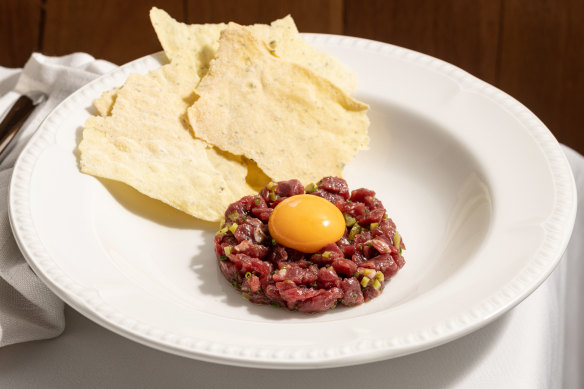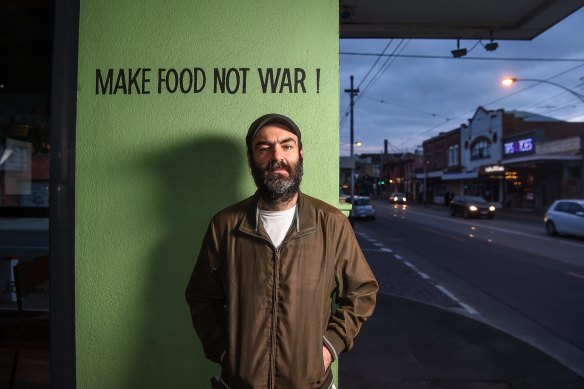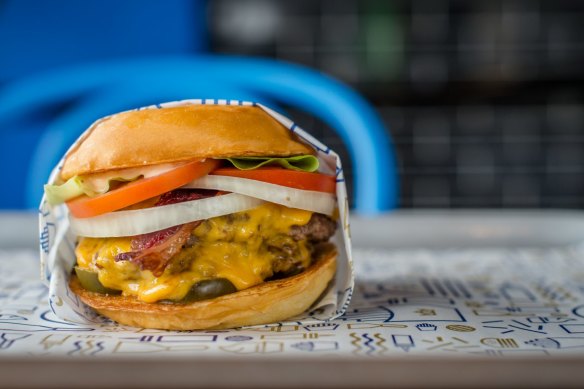Why one of Melbourne’s most on-trend restaurant dishes may disappear from menus
Melbourne restaurateurs say they are getting a raw deal with the introduction of the Victorian Department of Health’s list of eight “high-risk food items”.
One of Melbourne’s most on-trend restaurant dishes, steak tartare, is at risk of disappearing from menus as a set of new food safety rules make it more difficult and more expensive to serve dishes authorities have deemed high-risk.

One Fitzroy North restaurant has already been visited unannounced by their local health inspector and asked to remove a tartare dish from their menu or pay for a bespoke food safety program if they want to keep serving it.
“I have too many battles to fight, so we left this one,” says Neighbourhood Wine co-owner Almay Jordaan.
Jordaan says the spot-check happened two weeks before City of Yarra sent her any information about the new statewide laws.
In August 2022, the Victorian Department of Health identified hamburgers cooked rare, and raw red meat dishes such as steak tartare and kibbeh nayeh, on a list of eight high-risk items that now need special food safety programs in place.

The list ranges from well-known risky foods, such as raw egg mayonnaise, to fermented vegetables, recipes used by many cultures for centuries to preserve produce.
Sushi and other raw fish are not within the government’s sights. Carpaccio, an Italian dish comprising wafer-thin slices of raw beef, is also exempt.
Any venue preparing an item deemed high-risk needs to have a specially written food safety program in place that is independently audited. Businesses have to arrange and pay for this.
Asked why commonplace menu items such as tartare and kibbeh nayeh, a Lebanese raw meat dish, have been singled out, a health department spokesperson said: “There’s always been a requirement for food service businesses that prepare raw meat for consumption to develop audited food safety programs. There’s been no change to this requirement.”
“Where has been this pattern of people getting sick or even mildly sick from these dishes? In all my time in kitchens, no one has ever said ‘You’ve got to be careful preparing this dish’.”Joseph Abboud, Rumi
However, the big change is that restaurants are now required to develop “non-standard” food safety programs for the foods that have been deemed high-risk.
Jordaan estimates it will take several months and cost $2000 or more to develop a safety program and have it independently approved. One council officer she spoke to said lab testing for pH levels would also be necessary.
Rather than go through the new process, Jordaan chose to stop serving venison tartare at Neighbourhood Wine. “I’m too small to fight that,” she says.
Her other venue, Old Palm Liquor in Brunswick East, serves veal carpaccio with pickles and labne, a cheese-like strained yoghurt. That dish, according to Merri-bek council, is safe.
So far, it appears that City of Yarra is the only council raising the alarm on raw red meat.
While the law was changed more than a year ago, several businesses Good Food spoke to in different local government areas had not received any communication from authorities.
Many restaurants continue to serve tartare, unaware they are doing anything wrong.

“I just don’t understand what it’s based on,” says veteran restaurateur-chef Joseph Abboud, of contemporary Lebanese restaurant Rumi.
“Where has been this pattern of people getting sick or even mildly sick from these dishes? In all my time in kitchens, no one has ever said, ‘You’ve got to be careful preparing this dish’. And I’ve never heard of anyone having a [health] issue with it.”
The department of health did not respond to questions about whether a specific health incident had prompted the change.
Dani Zeini, owner of nine Royal Stacks hamburger restaurants, is not concerned about the rule change because his restaurants already cook their hamburger patties medium to well-done.

He says they changed the recipe several years ago to something closer to a smash patty, a thinner burger that is pressed during cooking so it has more surface area, in response to changes to food safety laws. He believes many other hamburger joints have also switched to the smash patty and will not be affected.
While Zeini would like to give the customer the option of a rarer burger, he understands where authorities are coming from. “Keeping the public safe is really important,” he says.
Restaurants, meanwhile, are scratching their heads about how the list of high-risk items was developed.
“I’ve had tartare on the menu since we opened. And I know that it’s on loads of different menus,” says Jordaan.
Neighbourhood Wine was also told to refrigerate 80 kilograms of pickles that were stored on shelves in the restaurant after being heat-sealed.
Many are expressing frustration and disbelief that their menus can be reshaped by authorities without evidence of danger to the public.
“I feel like this is one step towards making food in restaurants homogenous,” says Jordaan.
“It’s not just restaurants [affected],” she adds. “It’s suppliers as well, who sell things to be used for this application and now they can’t.”
The eight high-risk food activities being targeted
- Sous-vide cooking (cooking at less than 75C)
- Any potentially hazardous food that does not involve temperature control to minimise the growth of pathogenic or toxigenic organisms
- Preparation of acidified/fermented foods or drinks that are ready to eat and have a high level of acidity required to keep food safe
- Preparation of ready-to-eat foods containing raw unshelled eggs (unpasteurised)
- Preparation of ready-to-eat raw or rare minced/finely chopped red meats
- Preparation of ready-to-eat raw and rare poultry and game meats
- Off-site catering where ready-to-eat, potentially hazardous food is prepared or partially prepared in one location, transported to another location, where the food is served at a catering event
- Any other complex food process activity such as:
- Pasteurisation/thermal processing
- Packaging food where the oxygen has been removed and/or replaced with other gases for food safety or to increase shelf-life of the food
- Any food processing activity which does not involve the use of temperature control to minimise the growth of pathogenic or toxigenic organisms in food
Source: Victorian Health Department
Restaurant reviews, news and the hottest openings served to your inbox.
Sign up